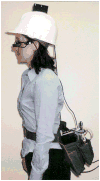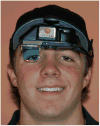Controlling motion sickness and spatial disorientation and enhancing vestibular rehabilitation with a user-worn see-through display
- PMID: 21181963
- PMCID: PMC4769875
- DOI: 10.1002/lary.21373
Controlling motion sickness and spatial disorientation and enhancing vestibular rehabilitation with a user-worn see-through display
Abstract
Objectives/hypotheses: An eyewear mounted visual display ("User-worn see-through display") projecting an artificial horizon aligned with the user's head and body position in space can prevent or lessen motion sickness in susceptible individuals when in a motion provocative environment as well as aid patients undergoing vestibular rehabilitation. In this project, a wearable display device, including software technology and hardware, was developed and a phase I feasibility study and phase II clinical trial for safety and efficacy were performed.
Study design: Both phase I and phase II were prospective studies funded by the NIH. The phase II study used repeated measures for motion intolerant subjects and a randomized control group (display device/no display device) pre-posttest design for patients in vestibular rehabilitation.
Methods: Following technology and display device development, 75 patients were evaluated by test and rating scales in the phase II study; 25 subjects with motion intolerance used the technology in the display device in provocative environments and completed subjective rating scales, whereas 50 patients were evaluated before and after vestibular rehabilitation (25 using the display device and 25 in a control group) using established test measures.
Results: All patients with motion intolerance rated the technology as helpful for nine symptoms assessed, and 96% rated the display device as simple and easy to use. Duration of symptoms significantly decreased with use of the technology displayed. In patients undergoing vestibular rehabilitation, there were no significant differences in amount of change from pre- to posttherapy on objective balance tests between display device users and controls. However, those using the technology required significantly fewer rehabilitation sessions to achieve those outcomes than the control group.
Conclusions: A user-worn see-through display, utilizing a visual fixation target coupled with a stable artificial horizon and aligned with user movement, has demonstrated substantial benefit for individuals susceptible to motion intolerance and spatial disorientation and those undergoing vestibular rehabilitation. The technology developed has applications in any environment where motion sensitivity affects human performance.
Conflict of interest statement
Conflict of Interest: The author has a financial interest in AdviTech, Inc., the commercial company that will market the technology developed and described in this research report.
Figures






References
-
- Rine RM, Schubert MC, Balkany TJ. Visual-vestibular habituation and balance training for motion sickness. Phys Ther. 1999;79:949–957. - PubMed
-
- Reason JT, Brand JJ. Motion sickness. London: Academic Press; 1975.
-
- Lawther A, Griffin MJ. A Survey of the Occurrence Amongst Passengers at Sea. Aviat Space Environ Med. 1988;59:399–406. - PubMed
-
- Reavley CM, Golding JF, Cherkas LF, Spector TD, MacGregor AJ. Genetic influences on motion sickness susceptibility in adult women: a classic twin study. Aviat Space Environ Med. 2006;77(11):1148–52. - PubMed
-
- Benson AJ, Barnes GR. Vision during angular oscillation: the dynamic interaction of visual and vestibular mechanisms. Aviat Space Environ Med. 1978;49:340–5. - PubMed
Publication types
MeSH terms
Grants and funding
LinkOut - more resources
Full Text Sources
Other Literature Sources
Medical

